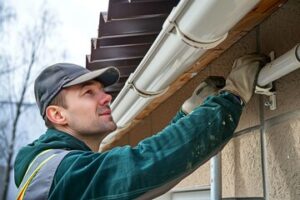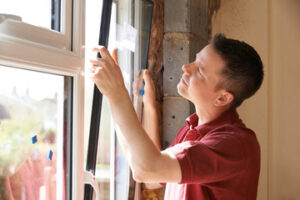Gutter Cleaning St Louis involves removing leaves, twigs, dirt and debris from gutters to prevent clogs that can lead to water damage. Regular gutter cleaning helps to ensure that rainwater flows away from the home and reduces maintenance costs.

Before starting, make sure you have a ladder that can reach all of your gutters and a bucket or tarp to dispose of debris. It’s also important to wear gloves to protect your hands from bacteria.
Gutters are designed to funnel water from the roof down into the downspout and away from the house. However, debris from the roof—twigs, leaves, shingles and even animals’ nests—can end up in the gutter, making it clogged. Damp leaves and other organic material also attract pests that can spread diseases or chew through your eaves, fascia, and soffits. Clogged gutters can also overflow, which can lead to wall and ceiling damage and water stains.
Eventually, if your gutters are not cleaned regularly, they will be completely blocked. This prevents the downspout from draining and will cause water to spill over the sides of the gutter, which can overflow into your garden beds, landscaping, and house, damaging plants and soil. Over time, this can also damage your foundation and cause cracks or shifts in the structure of your home.
Clogged gutters also overflow into the eaves and walls of your home, leading to wood rot and a host of other issues. In addition, the dampness from clogged gutters can promote mold and mildew growth that can affect your family’s health.
It’s important to clean your gutters at least twice per year—during spring and fall. You can do this yourself using a ladder, gloves, a gutter scoop and a garden hose to flush the downspout of debris. For more serious blockages, a plumbing snake or pressure washer may be necessary. To avoid getting dirty, you can also invest in gutter covers that can help reduce future clogging. Lastly, it’s best to hire professional gutter cleaners, as they have proper safety equipment and can spot other problems that you might miss. Many companies also offer a guarantee on their work, which gives you peace of mind that the job will be done correctly.
Clogged Gutters Can Be a Breeding Ground for Pests
Gutter debris is an attractive home for mosquitoes, flies, and other pests. Mosquitoes need standing water to lay their eggs and mature into adults, and the accumulated rainwater in clogged gutters is perfect for them. The stagnant waters and decaying leaves also provide the nutrients they need to thrive. Mosquitoes can carry diseases like the West Nile Virus and cause itchy mosquito bites that affect your backyard enjoyment.
Standing water in your gutters can also attract rodents. Rodents love the shelter and food sources found in clogged gutters, and they can damage the structure of your home and other structures nearby. They can also spread bacterial diseases that can harm your family’s health.
Clogged gutters can also be a breeding ground for birds and squirrels. Birds and other wildlife often build nests in the leaf and twig debris that collects in clogged gutters. These nests can clog your gutters further, and they may even damage your roof and eaves. In addition, they can bring secondary pests like fleas and ticks into your home, which pose a threat to your family’s well-being.
If you suspect your gutters are clogged, you can try using a plumbing snake to clear out the clog. Rotate the snake with gentle pressure to loosen and break up the clog. Then, remove the clogged debris from the gutter spout and dump it into a bucket. Once you have cleared out as much of the clogged debris as you can, flush the gutter spout with a hose. This will help to ensure that the clog is gone completely. If you can’t get rid of the clog with a plumbing snake, call a professional to do it for you.
Clogged Gutters Can Damage Your Roof
Gutters are designed to guide water from the roof to the ground and away from your foundation, but clogs prevent this process from happening. Instead, the resulting water pooling around your home causes serious issues that could require expensive repairs or even a full roof replacement.
Water overflow and roof leaks are the most obvious consequences of clogged gutters. Since the water can’t travel down the gutters, it will spill over and seep into vulnerable areas of the roof such as under shingles or between roofing layers. This moisture can cause rot and other damage to the roof’s structure, as well as leaking into interior walls and ceilings.
Standing water also encourages the growth of mold, mildew and moss. These fungi love damp, stagnant conditions and can quickly spread to the rest of your home’s exterior and inside its walls, creating health hazards that can lead to expensive damage. Regular gutter cleaning and effective gutter guards can help keep these fungi at bay.
Clogged gutters can also put strain on your soffits and fascia, which are essential components that promote air circulation and prevent moisture from penetrating the roof’s surface. Over time, the additional weight can cause them to sag or detach from your home’s structure. This puts your roof at risk of damage and leaks, as well as posing a fire hazard if the exposed wood gets wet.
Gutters that are clogged or overflowing can also drown landscape plants that sit in the puddled water and saturated soil. This includes hydrangeas, viburnums, rhododendrons and other flowering shrubs and trees. These plants need to be in well-drained soil to thrive, and if they are left in puddles or saturated ground for long periods of time, they will quickly die.
Clogged Gutters Can Damage Your Siding
Clogged gutters can lead to wood rot on the exterior of your home. The standing water in the gutters will attract mildew, which can then stain the siding of your house. If left unchecked, the rot can cause your siding to decay and warp, which will require expensive repairs. Regular gutter cleaning prevents these problems from occurring.
Standing water in your gutters will also erode the soil around your foundation. Over time, this can cause your foundation to shift and crack. It can also damage any wooden supports near your foundation, such as joists and beams. Clogged gutters also contribute to foundation problems by preventing rainwater from draining away from your house.
Gutters are designed to direct water flow from your roof, into the downspout, and away from your property. If the gutters are clogged, water will flow down the sides of your house and may spill over the edges. This can lead to wood rot, mold, and mildew on the siding of your house. Clogged gutters can also damage your landscape by causing water to spill over onto plants, trees, and lawns.
To clean your clogged gutters, you’ll need to climb a ladder and spray out the debris with a garden hose. Be sure to wear work gloves and eye protection while working. If you’re unable to remove the clog yourself, you can hire a professional gutter cleaner to help. A professional will use a gutter scoop or plumbing snake to remove stubborn clogs. They’ll also flush out the downspout with a hose to remove any remaining debris. They may also install a gutter guard to reduce future clogs. For safety, always work with a partner and follow proper ladder safety techniques.
Clogged Gutters Can Damage Your Foundation
Gutters and downspouts are designed to direct rainwater or snow/ice melt from your roof and away from the foundation of your home. If they become clogged, it can cause a wide variety of problems.
For starters, clogged gutters allow water to overflow. It can pool around your home’s foundation, causing structural damage and rotting wood. This can also lead to leaky basements, which is a serious problem that requires expensive repairs.
Over time, clogged gutters can also erode the soil around your foundation. This can cause the foundation to shift and settle unevenly, which can lead to cracks in the walls and basement. It can also cause the soil to be too wet, which is a recipe for mold and mildew growth.
Clogged gutters can also flood flower beds and garden areas, destroying or damaging plants. They can also erode soil and sweep away mulch, which is costly to replace. Gutter cleaning can prevent this by ensuring that water is channeled away from your home and landscape.
While clogged gutters can be easily prevented by regularly cleaning your gutters and downspouts, it’s not always an easy task. It usually involves climbing a ladder, which can be dangerous if you’re not comfortable with heights or don’t have the proper equipment. For this reason, many homeowners choose to hire a professional for regular gutter cleaning to ensure they are functioning properly and directing water safely away from their homes and landscaping. In addition, regular cleaning can help ward off pests and maintain the quality of your home’s exterior and foundation. It can also save you money on costly home repairs and reduce the risk of water infiltration or mold damage.



